Fittonia is a delightful perennial ornamental plant that makes an excellent decoration for any room. Fittonia stems are thin, brown, very dense and flexible. The leaves are oval-shaped, green, decorated with white, pink or red veins. Bright veins highlight the leaves of an indoor flower, giving it an exotic look.
Herbaceous plant native to South America, belongs to the Acanthaceae family. Fittonia flowers are small, yellowish color, collected in a spike-shaped inflorescence.
Initially, Fittonia was grown in greenhouses and winter gardens, since it usually died at home. Today, plant varieties have been developed that are not so picky about air humidity and temperature and grow well at home.
Main types of Fittonia and photographs of these species
To date, flower growers have been able to develop several types of phytonia that can be grown in an apartment. The genus Fittonia consists of four species of perennials herbaceous plants with beautiful leaves of various green, pink, white, purple shades. Red Fittonia looks especially unusual and exotic, the veins on its leaves form an intense, beautiful pattern.
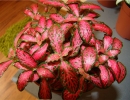
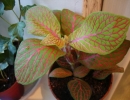
![]()
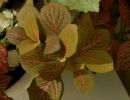
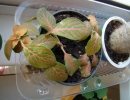
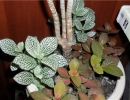
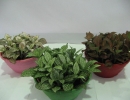


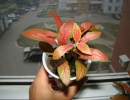
This type of plant is characterized by the presence of beautiful large dark green leaves with a pattern of white, red and pink veins. The stems of Fittonia Verschaffelta are highly branched, with creeping shoots.
A low-growing plant no more than 25 cm high, it loves high humidity and a warm growing environment. Great for creating flower arrangements.
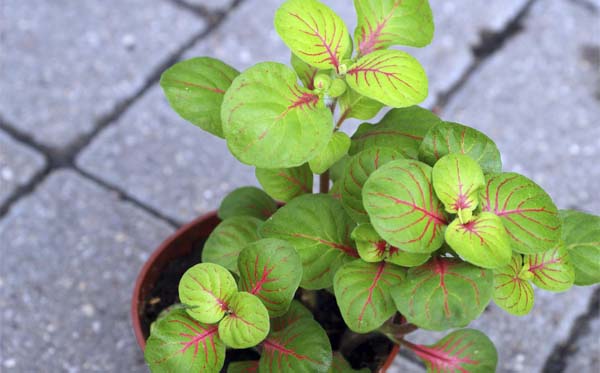
This species got its name because of its color and leaf structure.
This type of indoor plant is very beautiful and elegant, with creeping shoots. The small, velvety, matte leaves of Fittonia skeleton are decorated with a dense network of red veins. The leaves are a rich olive color, their coloring is so intense that it creates a luminous effect.
A low perennial plant whose main decoration is its leaves. This species contains several varieties of plants that are planted together.
The color of Fittonia mix leaves varies from light to dark green shades, with multi-colored bright veins. This plant looks great on the windowsill due to its variety of colors.
Caring for indoor Fittonia flower at home
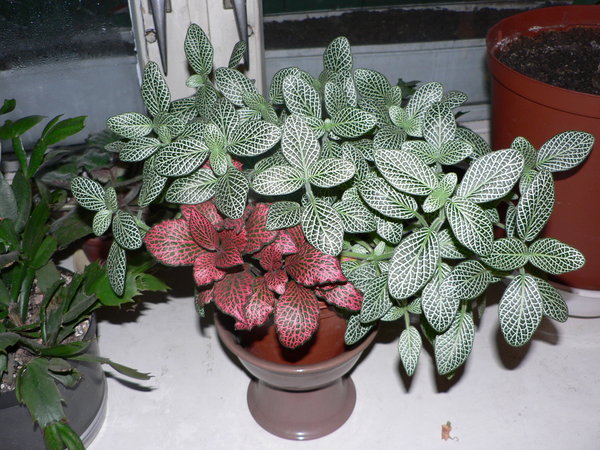
Remember that the temperature should not fall below +18 degrees, otherwise Fittonia will begin to shed leaves
If you follow the recommendations of specialists, caring for Fittonia at home is not particularly difficult. Due to its decorative qualities and relative unpretentiousness, this plant is very popular among gardeners.
Optimal temperature
Fittonia is a heat-loving plant, therefore optimal temperature air for growing in summer should not be lower than 22 - 25 degrees, in winter - within 20 . If the temperature is below 18 degrees, Fittonia sheds its leaves. This indoor plant does not tolerate drafts or sudden changes in air temperature. Therefore, it is not recommended to take Fittonia out onto the balcony even in summer. In winter, the plant should not be placed near heating devices.
Lighting for Fittonia
Like many indoor plants, Fittonia loves bright rooms. It is not recommended to place the plant on sunny windows on the south side. Under the influence of direct sun rays Fittonia may die. It is best placed on eastern and western window sills. The plant tolerates light shade well. In winter, if there is a lack of lighting, Fittonia leaves lose their beautiful color. Therefore in winter time It is recommended to increase daylight hours for the plant using special lamps.
Humidity

Fitonia is not only a heat-loving plant, but it also loves high humidity.
When caring for Fittonia, you should remember that it loves high air humidity. It is advisable to spray the plant throughout the year, using settled or filtered water. If the indoor air is dry, it is recommended to spray Fittonia twice a day. To increase humidity, a pot with an indoor flower can be placed on a tray with expanded clay or pebbles. It is strictly forbidden to use leaf polishing agents..
Watering Fittonia
From the beginning of spring until autumn, Fittonia needs to be watered abundantly and regularly with warm, settled water. Late autumn and in winter, watering is gradually reduced. However, the earthen ball should not be allowed to become dry, since even if the root part dries out once, the leaves of the Fittonia fall off. The plant intensively evaporates water from its leaves, as a result of which moisture from the soil evaporates very quickly. The soil in the pot should always be slightly moist, but water stagnation should not be allowed, since excessive moisture leads to rotting of the plant's root system.
Soil composition and fertilizers
The soil for Fittonia to grow should consist of a mixture of humus soil, peat and sand. Considering that root system plants are superficial, it is recommended to use shallow but wide pots and containers, the bottom of which must have drainage installed.
From April to September, during the active growing season of Fittonia, it needs to be fed regularly mineral fertilizers. However, since the plant is very sensitive to excess fertilizer, their concentration must be halved from the usual dose indicated on the package.
Rejuvenation

Every year in the spring, Fittonia must be replanted
Approximately every three to four years, Fittonia needs to be rejuvenated. This is determined as the lower part of the shoots becomes exposed. To rejuvenate the plants, the most elongated branches are cut off, which are rooted in the ground under glass. Rejuvenation is also carried out by splitting off the upper shoots of the plant and rooting them. After this, after some time, Fittonia throws out new side shoots.
Fittonia grows very quickly, so in the spring it needs to be transplanted into a larger pot or container. It is recommended to replant young plants annually.
How to propagate Fittonia
Fittonia is propagated by apical cuttings. Cuttings from shoots are planted in moist soil, regularly sprayed and watered. After rooting the cuttings, they are transplanted to a permanent place in the soil, which consists of a mixture of earth, peat, humus and sand. The plant is also propagated by dividing the bush during transplantation or by seeds. In spring, the seeds are planted in a container with soil, which is constantly kept moist at a temperature of at least 22 degrees.
Plant diseases, pests and their control
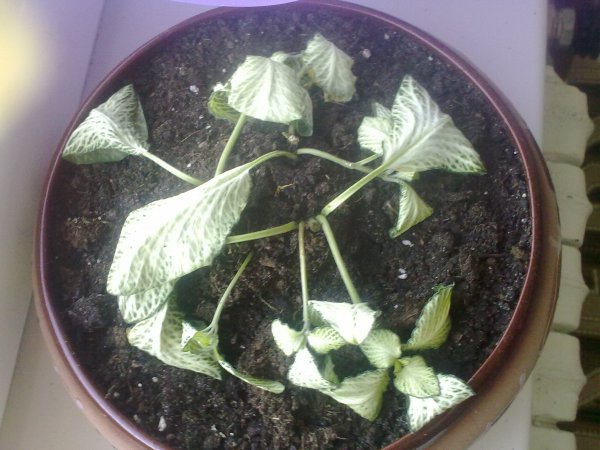
The photo shows a sick houseplant Fittonia
The main pests of Fittonia are scale insects and spider mites. Scale insects are located on the surface of leaves and stems in the form of brown plaques. They suck out the plant's cell sap, causing the leaves to lose their color and dry out. To combat this pest, the leaves are wiped soap solution, and then sprayed with a 0.15% Actellik solution.
When Phytonia is infected with red spider mite Inconspicuous whitish spots form on the leaves, and a cobweb can be seen under the leaves of the plant. Dry air in the apartment contributes to the infestation of plants by mites. Spraying the leaves and stems with derris, fitoverm, fufan will help get rid of this pest.
The main signs and causes of fittonia disease:
- The tips of the leaves are dry and brown. The cause is too dry indoor air.
- The leaves of the plant are yellow-brown when there is an excess or deficiency nutrients contained in the soil.
- Leaves curl and become stained due to insufficient watering.
- Sluggish, rotting stems of the plant - temperatures below 18 degrees with high air humidity.
- The plant's leaves fall when the air is too dry or when it is overwatered.
- Fittonia leaves lose color, become thin, and dry out. The reason is intense sunlight.
Indoor plants in a round or rectangular aquarium will give an exotic look to any room. Fittonia is perfect for placement in an aquarium, since the root part of the plant tolerates being in damp soil and high humidity. The upper part of the plant is exposed to the air, which is also sufficiently humidified.
You can also familiarize yourself with the video material on the indoor plant Fittonia, we wish you pleasant viewing.
Peculiarities of caring for hypoesthesia houseplants, interesting subtleties in their maintenance and little secrets that will help maintain the beautiful shape and color of the flower for a long time. Hypoestes is a member of the Acanthaceae family.
In English-language literature, “hypoestes” are called “polka-dot plant” - “polka dot plant”, which is easy to recognize by looking at its original appearance.
It has a very impressive outfit thanks to its bright spotted leaves of burgundy, white, pink color, on which green veins are visible. There is also a purple variety with white and yellow streaks.
Two attractive species received particular recognition.
Hypoestes blood red(Hypoestes sanguinolenta Hook.) - a beautiful subshrub, barely reaches 50 cm in height, densely branched. The leaves are narrowly ovate, 5-8 cm long and 3-4 cm wide, slightly wavy at the edges, entire, dark green in tone, with purple-red veins and small spots from pink to purple (depending on the variety). The flowers are small, the corolla is light purple, with a white throat.
Hypoestes phyllospica(Hypoestes phyllostachya Baker) - a species close to the blood red (H. sanguinolenta). “Polka Dot”, which can be translated as “Varied peas”. It has soft purple-red leaves. Flowers are solitary, axillary, lavender colored.
In culture, hypoestes are represented by numerous varieties and forms.
The original color combination is no longer the only one. You can find almost completely pink leaves or white with small green spots, border and contrasting veins... The most popular are the low-growing varieties of the ‘Confetti’ and ‘Splash’ series.

In the photo: Hypoestes phyllostachya “Confetti White” - white-greenish with green veins...
How to care for hypoesthesia at home
Hypoestes is very easy to care for, grows well in city apartments, and is well-suited to warmth, moisture and bright light. Does not tolerate heat and drought well. Temperature in summer 18-25 degrees, in winter - 18-20.
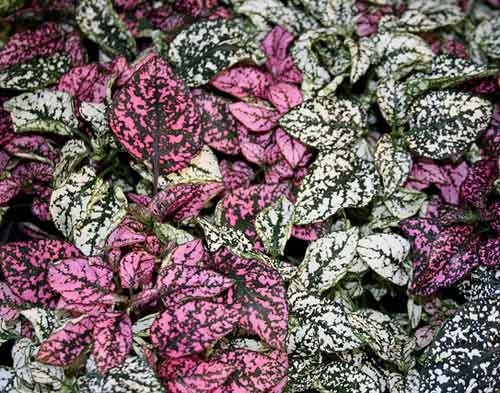
Like coleus, hypoestes needs a sufficient amount of sunlight, but if the first can restore its burgundy color after wintering, then the second loses it forever. The plant is shaded from the midday sun.
The color of the leaves depends entirely on the intensity of light, the type of soil and fertilizing.
Since hypoesthes does not have enough light in winter, it is recommended to place it on the lightest windowsill. If you do not monitor the color preservation in time, then it will be impossible to return the rainbow color and you will have to plant the plant again - from seeds, cuttings, or wait until the root system produces new stems.
Mist the leaves frequently to ensure high air humidity. Place the pot in a large planter filled with damp moss, peat, or a water-filled bowl of pebbles. Regular watering with soft water, but only after the top layer of soil has dried out a little. In winter, reduce the frequency of watering along with a slight drop in temperature.
From March to September, feed with mineral fertilizers every 2-3 weeks; it is useful to fertilize with potassium. In winter, the dosage of fertilizers is slightly reduced, but not stopped (once a month). With a lack of nutrition, the edges of the leaves darken and dry out. By the way, the solution from laundry soap will also be useful.
At good care Hypoestes grow for many years, but young specimens look more attractive.
To this type retained its aesthetic shape, it is recommended to pinch it, otherwise the stems will stretch, dry out and die. If this happens, do not be upset and do not throw away the flower. Just cut off the withered stem and continue to water the soil - a healthy root system will definitely produce offspring.
Hypoestes blooms modestly - they appear along the stem small flowers. A plant with red and pink leaves gives purple flowers, with white – white. When they dry out, they can be collected and planted in a pot in the spring. Small seeds will definitely germinate.
Problems in caring for the hypoestes plant
It is resistant to diseases, but insufficient care can lead to undesirable consequences:

- Drying of leaf edges is caused by dry air;
- The falling of leaves is explained by drafts, insufficient watering and low temperatures - do not allow the soil to dry out;
- The leaves turn yellow and wither - there may be excessive watering or waterlogging;
- Pale leaves, loss of spotting, leaves turning green - lack of lighting.
- Spots on leaves may become lighter due to overfeeding with nitrogen fertilizers;
- Brown spots are a consequence of burns;
- No access fresh air the plant can become easy prey for spider mites.
The plant looks drooping and weak if it is cold and is in too wet soil... It does not tolerate smoke, gas combustion products, drafts, and needs ventilation.
For appearance Hypoestes needs to be monitored by properly caring for the flower to avoid some problems.
Reproduction and rooting of cuttings
For cuttings of hypoestes, only apical cuttings of 3-4 leaves, 8-10 cm long, are used. The shoots are cut in spring or early summer. Dip the end of the cutting into a growth stimulator (kornevin). Planted in a mixture of peat and coarse sand. Cover the pot with plastic wrap and place in a bright, warm place. When the hypoestes cuttings begin to grow, pinch off the growing tip.
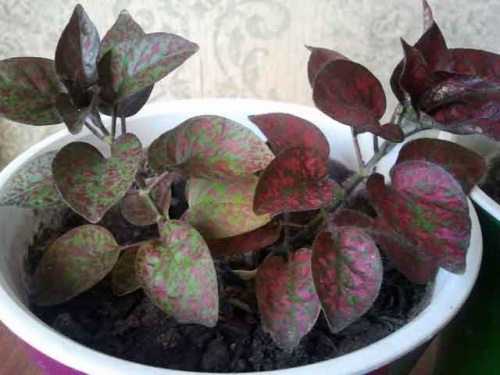
Growing hypoestes from seeds
In March or April, several hypoestes seeds are sown in one container, covered with plastic wrap. Shoots appear quickly. When the seedlings reach 15 cm in height, pinch out the growing tips to encourage the young plants to tiller. After 3-4 months, hypoestes take on the appearance of a fully grown plant.
He has a phenomenal ability to reproduce. The plant is prone to self-pollination and small seeds periodically germinate in one pot or another. This drawback can be easily eliminated. The hypoestes is simply not allowed to bloom by regularly removing the emerging buds.
Flower shops offer seeds of varieties from the ‘Confetti’ and ‘Splash’ series; the height of the grown plants is 10-25 cm.
- “Pink Veil” - green, abundantly covered with pink strokes and spots;
- “Pink” (Confetti Pink) – pale pink with green veins and edges;
- “White” (Confetti White) - white spots on the dark green surface of the leaf with greenish veins and edges;
- “Red Wine” (Confetti Wine Red) – dense green with a burgundy tint and small cyclamen spots and streaks.
- “Red” (Confetti Red) - most of the leaf surface is crimson-red, only burgundy-green spots are applied along the veins and along the edge;
- “Crimson” (Confetti carmine-rose) - numerous small pale pink spots are scattered across the burgundy-green surface of the leaf.
- “Pink Splash” - the leaves of blood-red hypoestes are speckled with pink;
- “White Splash” - a beautiful cream-colored pattern is visible on the leaves of the variety;
- “Splash Red” - the entire surface is evenly covered with crimson and red-green spots.
At home care the attitude of young hypoestes to sunlight and humidity should be taken into account...
Plants with variegated, brightly colored leaves always attract the eye. They can serve as decoration for an apartment, office or study.
Types of plants with beautiful leaves
Variegated leaves may be various types plants, but the most interesting are coleus.
Coleus Bloom, depending on the variety, may have large or small elongated heart-shaped leaves. They can be of various colors, velvety in appearance and always variegated. The color of the leaf blades is very varied. White, red, burgundy, pink, lilac, crimson, leaves. The pattern may be marble, large and small spots, stripes with tints, specks, stains. The color range of the edging and its width are also very diverse.
Many variegated forms are found among begonias. The leaves of Begonia white-colored, bright green are covered with small white spots. Alfalfa begonia has dark green leaves covered with white dots. The leaves of the “Royal Begonia” amaze you with its beauty. Their color is bright metallic green, pink, crimson, lilac to purple at the edge of the leaf closer to the center with a silvery belt. The lower part of the leaf blade is almost always red.

Hypestes, a flower with multi-colored leaves. Its leaves have a blood-red hue and are covered with pinkish spots.
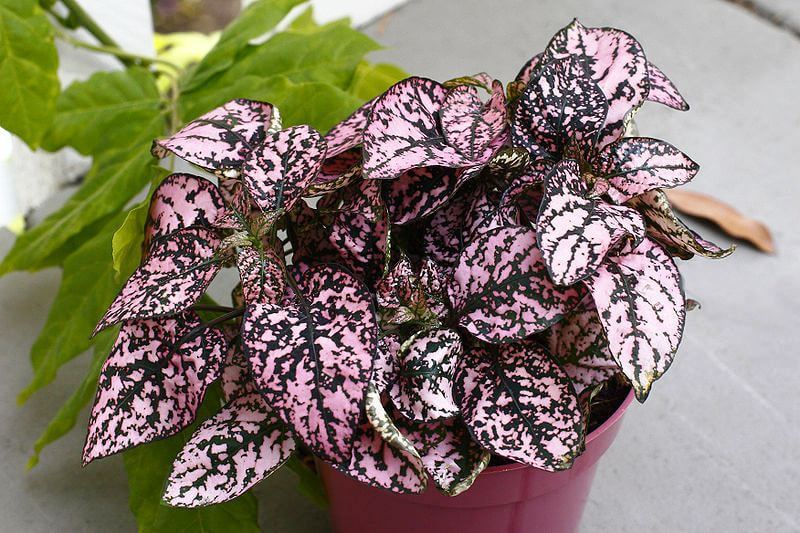
Aglaonema Freda strikes with its narrow, variegated leaves. They are gray-bluish-green with gray-silver longitudinal diagonal stripes.

Variegated aspidistra has white longitudinal stripes along the veins, on dark green leaves.
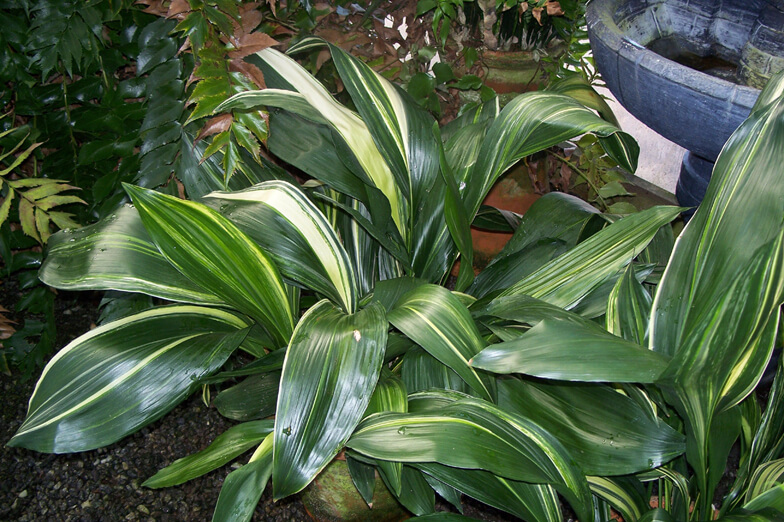
Anthurium - majestic white color repeats the pattern of large veins.

Caladium is bicolor, distinguished by the red color of the central part of the leaf, diverging along the veins to the edges of the leaf. The green edging is dotted with small white spots, is wide and does not have a clear outline.
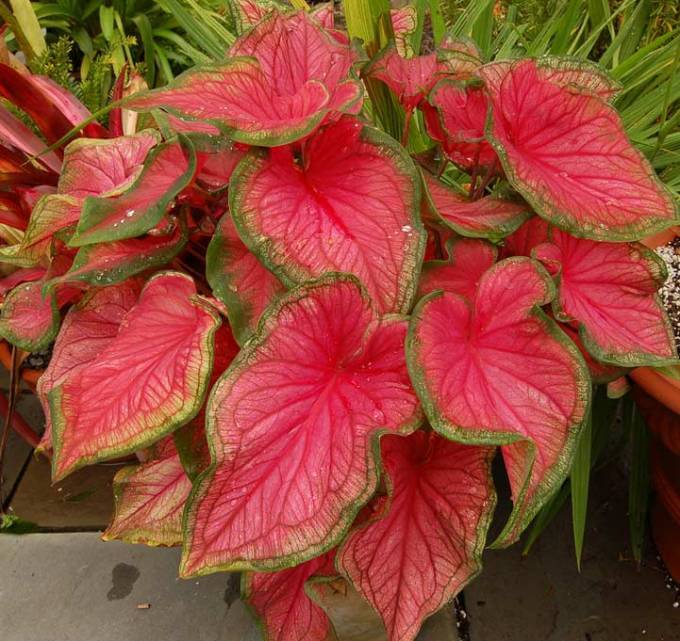
Calathea ornate has very beautiful dark green leaves, with a white feathery pattern extending from the central vein to the edges.
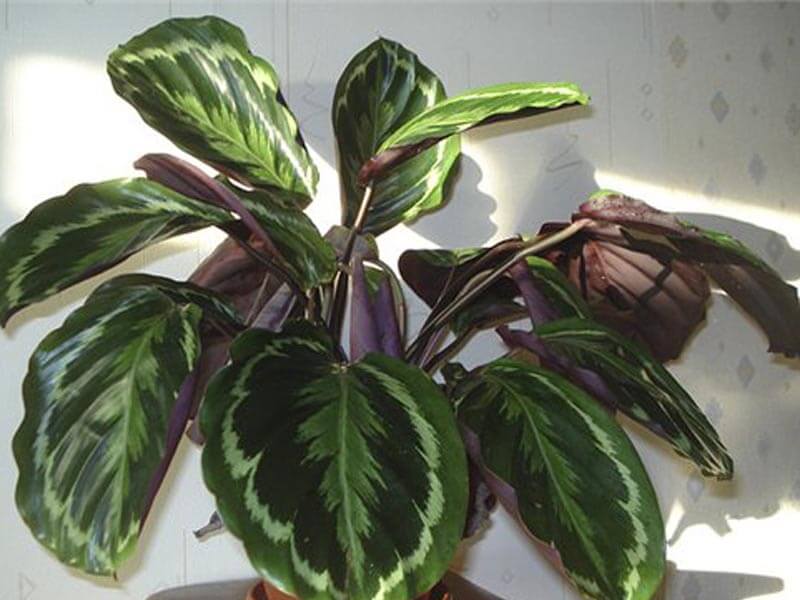
Codiaeum, croton. It has wide or narrow, rugged or entire edges, variegated and brightly colored in lilac, yellow, orange, pink, red, and green leaves.
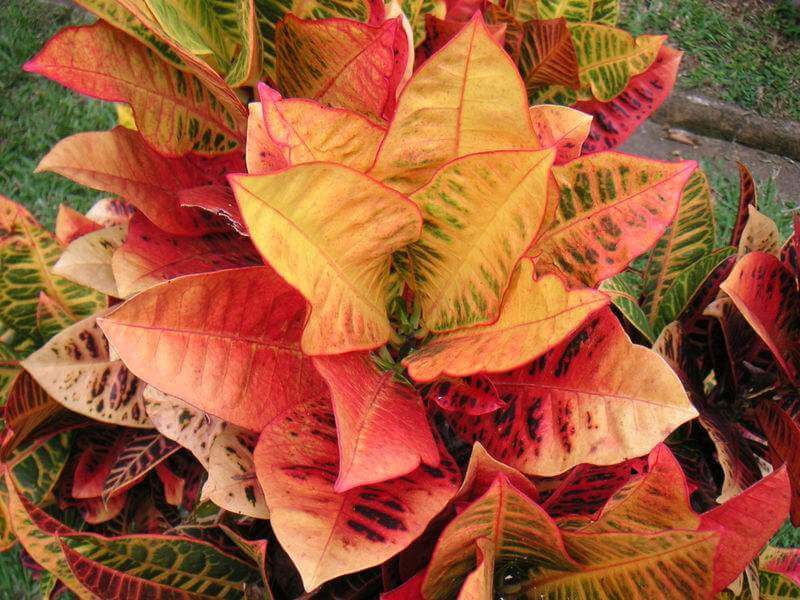
Arrowroot, a form of Kerchoff, is a plant with exceptionally beautifully painted leaves. Widely oval leaves, up to 15 cm long, seemingly sitting on short petioles, bright green, with dark brown feather-like or ocellate spots located in two rows and a light stripe along the central vein. The undersides of the leaves are bluish-green to reddish.
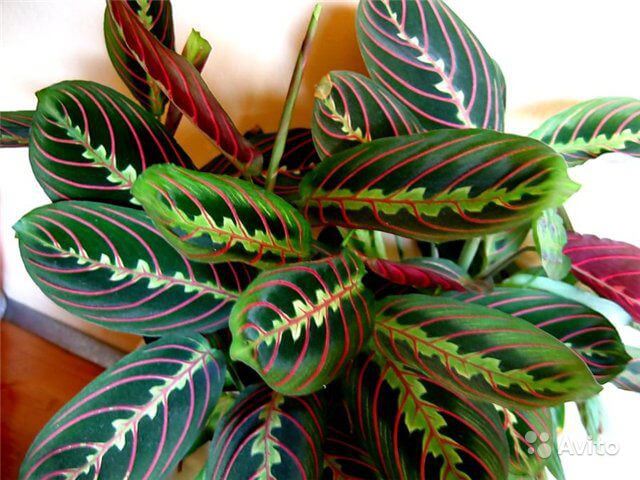
There is absolutely no need to wait for a magical flowering period, because quite a huge number of indoor ornamental plants have amazingly beautiful variegated or green leaves.
What indoor plants will give your interior a positive mood? You can find the answer to this question in this article, which is dedicated to seven wonderful decorative flowers.
When looking for unusual and bright flowers, it is worth paying attention to such representatives of the “mutated” flora as begonia, hypoestes... Flowers with red leaves, such as coleus, codiaum, poinsettia, etc., attract special attention from flower growers.
Coleus blumeii
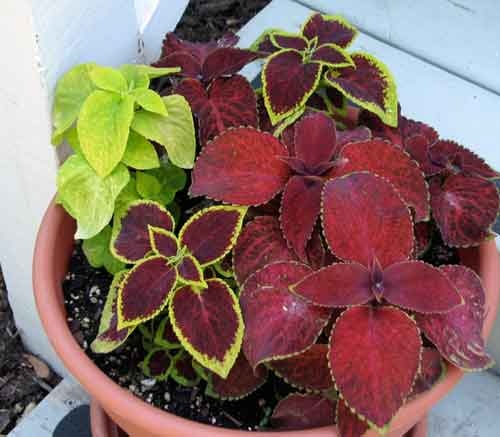
In the photo: coleus with red-burgundy leaves...
This decorative beauty, which arrived from the tropical latitudes of Africa and Asia, quickly took root on the windowsills of residents of northern latitudes. Picturesque burgundy leaves with a barely noticeable green or other color edging become the best memory of the rainbow colors of summer during a snow-white and cold winter. Interestingly, the color of coleus leaves largely depends on the amount of sunlight.
Hypoestes
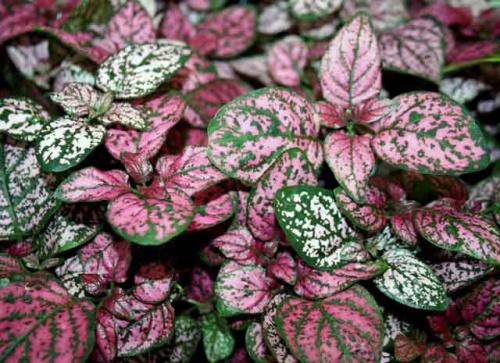
The main competitor to other indoor plants - the multi-colored decorative leaves of hypoestes will delight any gardener.
Maintaining a luxurious variegated color is far from easy, requiring bright lighting and humidity. Depending on the variety, the color can be white, pink or bright red, while spots and patterns determine the color perception of the entire plant.
Fittonia
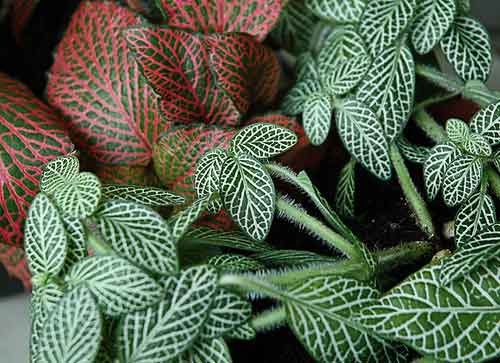
Photo: indoor Fittonia with very interesting leaves covered with silver, red, pink mesh patterns...
Small leaves of fittonia and hypoestes will create colorful spots in the decorative composition. True, these plants tend to stretch out, so constant pruning and pinching will be an indispensable condition for them.
Variegated codiaeum, or Croton

Growing in its homeland, croton reaches a length of one and a half meters, at home - 40-80 centimeters. The unusual look of this decorative flower is manifested in the fact that the leaves of the codiaum are varied - long, twisted, with fancy cuts, yellow, green, orange, red - they give originality to the shrub. The leaves that are located at the top of the plant change color as they grow.
Iresine - plant with red leaves

Belongs to the Amaranth family (Amarathaceae). Mainly ornamental species are grown: Herbst (Iresine herbstii) and Linden (Iresine lindenii), which are valued for the unusual color of their leaves, with pronounced veins. The plant reaches a height of 60 cm. If you trim the ends of the shoots, you can get an amazingly beautiful lush bush.
The varieties are also beautiful with their reddish stems and soft green leaves with red and golden yellow veins.
Royal begonia (Begonia rex)

Speaking about the decorativeness of elegant leaves, we cannot fail to mention the royal begonia - one of the most common plants in our house. She is like a real queen - she loves space.
The size of the bush and leaves can be from miniature to large. The leaves appear velvety, in various color and pattern combinations, some with a metallic silvery sheen, marbled pattern. The shape can be simple round, oblong, heart-shaped, snail-shaped, feathery, slightly or deeply dissected, stellate. The edges of the leaves are often jagged or wavy...
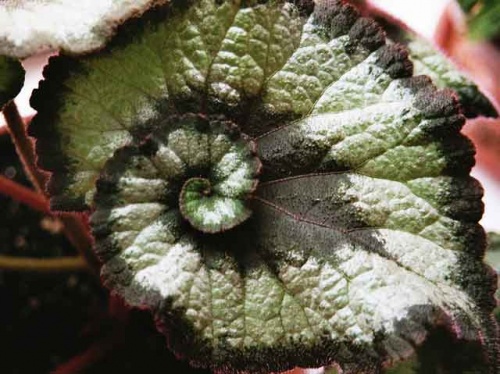
In the photo: begonia "Escargot" - leaves with a spiral on long petioles, shaped like a snail's house, for which it received the name "royal snail".
Poinsettia (Euphorbia pulcherrima)
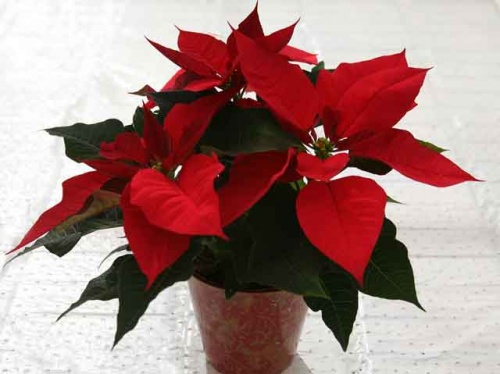
Another gift of nature is the poinsettia, which fascinates with its green-red leaves (red bracts). True, to enjoy this beauty, you need to carefully care for it.
These are the nuances associated with bright variegated or green plants that will become a pearl on any windowsill. Evaluating decorative leaf indoor species by ease of care, we can say that the most unpretentious, of course, is coleus, followed by hypoestes, and only then the rest of the plants.
But everything is not so complicated, the main thing is to treat indoor flowers with love, and they will certainly repay you with rich color, lush shapes and a good mood.
Codiaeum is an evergreen shrub with large leathery leaves, very diverse in shape and color. Some varieties of flower have codiaum sheet plates so bizarre or elegant, and the coloring is multi-colored and artistic, that the entire bush looks like a huge exotic plant.
The main advantage of this codiaum flower is its longevity; with good care it will not wither for many years. IN Southeast Asia and on the islands of the Pacific Ocean there are about 15 species belonging to this genus of the Euphorbiaceae family. In nature, these are large shrubs or evergreen trees about 3-4 m high. In indoor floriculture, only the variegated codiaeum (Codiaeum variegatum), or croton, and numerous hybrids and varieties derived from it are used.
Indoor flower codiaum variegated or croton
Variegated codiaeum, or croton (Codiaeum variegatum var. pictum) is an evergreen shrub up to 1.5 m high with large (about 30 cm long), leathery, shiny leaves of various shapes - narrow or wide, laurel-shaped or ribbon-shaped, spirally twisted or bizarre -cut out.
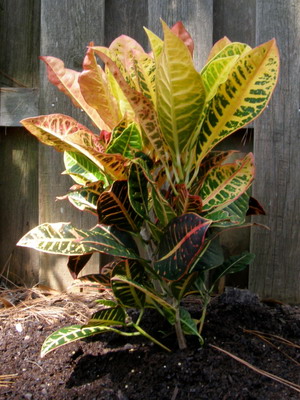
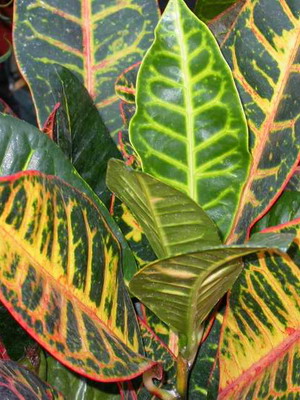
The young leaves of the indoor codiaum flower, located in the upper part of the bush, are green or slightly yellowish, but as they grow older, their variegated multi-colored color appears: yellow, red, orange, brown, located in spots or along the veins. Some varieties have such an intricate pattern on the leaves that one gets the impression that it was painted by an artist.
Croton very rarely blooms in room conditions, and if it does bloom, it is better to cut off the flowers, as they greatly weaken the plant and are not particularly beautiful. The croton flower is strewn with small white-yellow balls with fluffy stamens, collected in loose racemes.
Varieties of codiaum (croton) in the photo
There are many varieties of codiaum on sale, differing in the variety of colors, petal shapes and stem heights.


Aucubofolia- The yellow pattern on the green leaves resembles the color of Aucuba leaves.

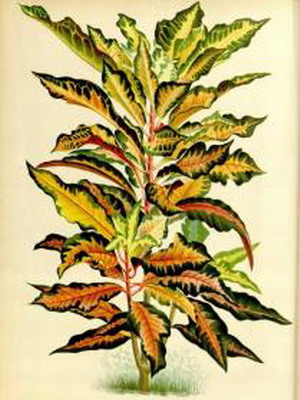
Baron J. de Rotschild- leaves of different ages change color from olive green to pink and orange. As you can see in the photo of the croton, the veins on all the leaves of this variety of codiaum are emphasized in red.

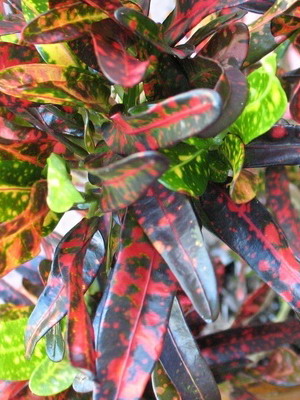
Batic- the leaves seem to be painted using batik technique.
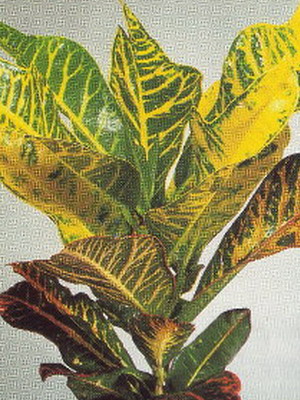
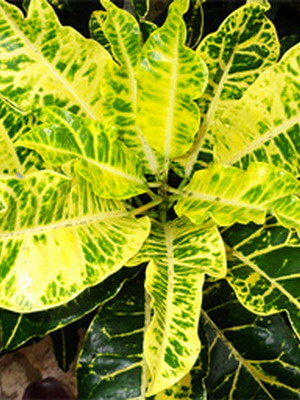
Bravo- leaves are green with yellow spots.
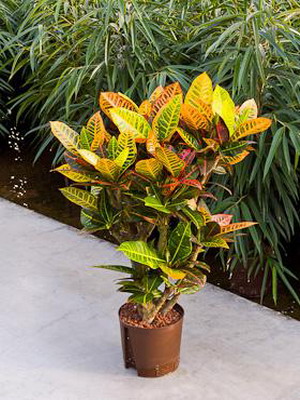
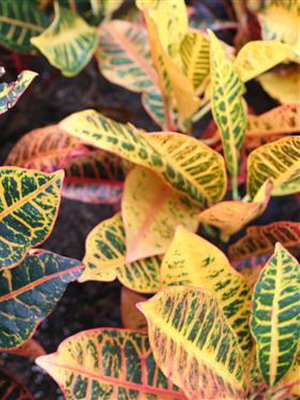
Norma- the main background of the leaf is green with yellow spots and red veins.
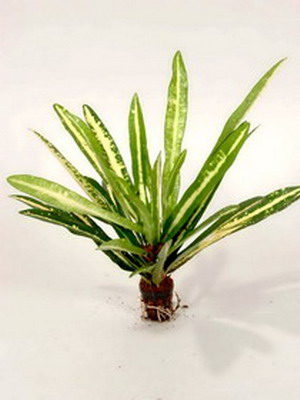
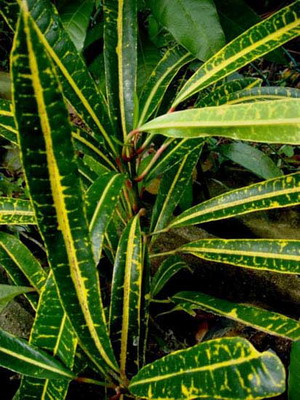
Gold Finger- the leaves are long, narrow, green, with a yellow stripe running along the central vein.
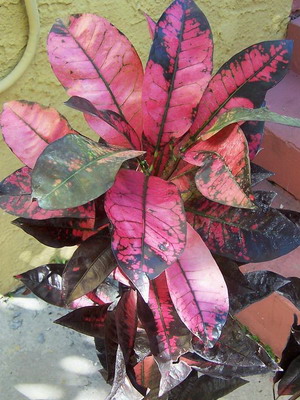
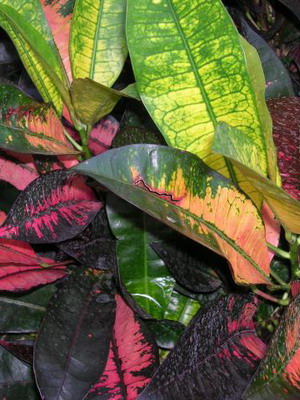
Mrs Iceton- the leaves are large, ellipsoid in shape, young leaf plates are colored yellow-green, and more “adult” ones are red-orange with a transition to dark green.

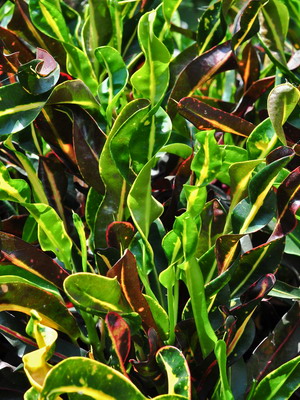
Spiral- red and green leaves are twisted in a spiral.
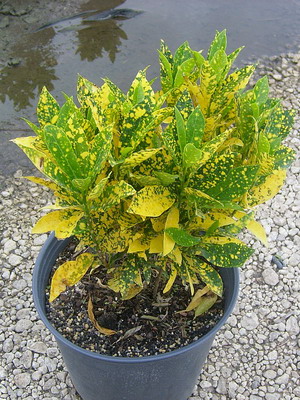
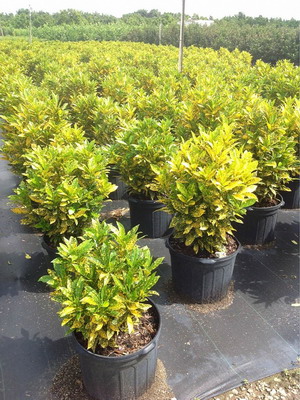
Yellow Snow- yellow spots on a green background, reminiscent of snow flakes.
There are varieties of codiaum, photos of which are presented in our photo gallery, with less artistic coloring of the leaves. However, this is offset by their intricate shape.
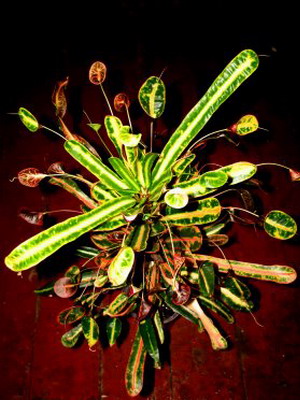
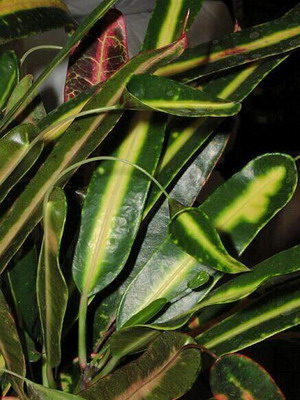
Golden Bell- leaves with constrictions.
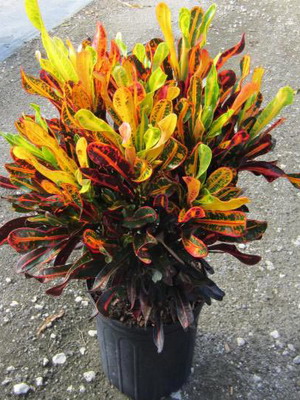

Mammie- leaf plates are strongly twisted.


Mascarena- the leaves are straight, narrow, but hang down, and not directed upward like other varieties of codiaum.
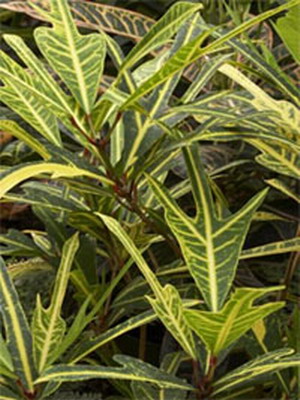

Сraigii and Нoluffiana– varieties with lobed leaves.
In interior decoration, the plant can be used both as a tapeworm and in flower arrangements.
Caring for codiaum (croton) at home
Codium (croton) is often, by analogy with other euphorbias, classified as unpretentious plants. However, in order to see the plant in all its glory, you will have to try to provide it with optimal conditions. The main one is consistency, that is, the level of illumination, temperature, watering and air humidity all year round should be approximately the same. It should, however, be taken into account that bright lighting, which is necessary for the richness of the colors on the leaves, occurs on a south window in winter, and in summer the same lighting occurs on an eastern or western window. When caring for codiaum at home, care should be taken to protect the plant from direct sunlight, which can cause burns on the leaves.
The temperature in winter should be maintained at +18 +24 °C. Watering should be such that the lump of earth is constantly moist, that is, abundant in summer, but without stagnation of water (good drainage is required), and less frequent in winter. In hot weather and during the heating season, croton needs to be frequently sprayed and even washed. If the air is very dry, indoor flower Codium can shed its leaves, and a new one will never grow in place of the lost leaf. The plant does not tolerate the presence of lime in water.
During the period of active growth, in spring and in the first half of summer, croton is fed once every 2 weeks, if possible alternating mineral and organic fertilizers.
Caring for croton at home involves annual replanting of young plants. The codiaum flower must be replanted using the transshipment method, since its roots are very easily injured. It is permissible to replant older crotons once every 2-3 years. A compact crown is formed by pruning, which can be done throughout the year. On young shoots with three or four formed leaves, the growing point is pinched, which slows down the growth of shoots in length and stimulates their branching. Codiaum is propagated by apical cuttings, which are rooted in any substrate or even in water. To speed up the process, it is better to use phytohormones.
